How to Clean Old Wood Furniture: Complete Restoration Guide
Learn the best methods to clean old wood furniture with our step-by-step guide to restoring antique pieces and bringing solid wood furniture back to life.
- May 20, 2025
- joshenns003@gmail.com
- 5:10 pm
Introduction to Old Wood Furniture Care
There’s something special about old wood furniture that new pieces simply can’t match. Whether it’s an antique family heirloom, a vintage find, or a quality piece that’s seen better days, old antique furniture has character, history, and often superior craftsmanship.
Over time, however, even the finest wooden furniture can become dirty, dull, or damaged. Years of use, improper care, and environmental factors can leave your cherished pieces looking less than their best. Fortunately, with the right approach, you can clean and revitalize almost any old wood furniture.
This guide will walk you through the process of properly cleaning various types of wood furniture, from basic dusting to addressing stubborn grime. For more specific issues like mold, you might want to check our guide on [cleaning mold from wood].
With proper care, your quality wood furniture will continue to bring beauty and function to your home for generations to come.
Before You Begin: Assessing Your Furniture
Before diving into cleaning, take time to understand what you’re working with. Old wood furniture requires careful assessment to determine the appropriate cleaning method.
First, identify the type of wood and finish. Is it solid wood furniture or veneer? Is the finish oil, lacquer, shellac, or polyurethane? Different finishes require different cleaning approaches. If you’re unsure, check in an inconspicuous area like the underside of a table or the back of a dresser.
Test any cleaner in a hidden spot before applying it broadly. This precaution is particularly important with old antique furniture where finishes might be delicate or deteriorating.
Gather these supplies before you begin:
- Soft, lint-free cloths
- Soft bristle brushes
- Mild dish soap
- Distilled white vinegar
- Olive or mineral oil
- Commercial wood cleaner
- Wood furniture polish
- Protective gloves
- Small containers for mixing solutions
When working with very old or valuable pieces, always err on the side of gentleness. Sometimes, less cleaning is better than risking damage to precious wood surfaces.
Understanding Different Wood Surfaces
Know your wood furniture type before cleaning. Different woods and finishes need specific care approaches.
| Wood Type | Characteristics | Cleaning Considerations |
|---|---|---|
| Solid wood furniture | Made entirely of real wood throughout | Can handle more moisture, more forgiving |
| Veneered wood | Thin wood layer over substrate | Very vulnerable to moisture, needs gentle cleaning |
| Light wood furniture | Maple, ash, birch, pine | Shows water marks easily, needs immediate drying |
| Dark wood | Walnut, mahogany, cherry | Shows dust more, hides minor scratches |
| Old antique furniture | Pre-1930s pieces | Often has delicate shellac or varnish finishes |
| Modern wood | Contemporary pieces | Usually has durable polyurethane finishes |
Wood finishes vary widely in durability:
- Oil finishes soak into the wood but offer minimal protection
- Shellac creates a warm glow but water and alcohol damage it easily
- Lacquer provides hard protection but heat damages it
- Polyurethane offers the strongest protection layer
Natural wood furniture with oil finishes needs gentle, frequent care. Modern polyurethane finishes can handle stronger cleaners.
Age matters too. Craftsmen made old antique furniture before 1930 with traditional finishes that harsh modern cleaners can damage.
Light wood furniture shows stains more clearly, so you need to prevent water marks and dry immediately after cleaning.
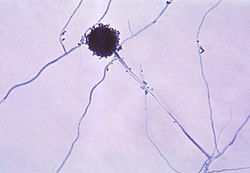


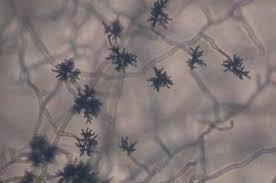
Understanding Mold Types on Wood
Aspergillus
Aspergillus is common on wood furniture. It shows up as yellow-green to black spots and loves humid homes. This mold can grow on both sealed and raw wood. People with breathing problems should be extra careful around this type of mold, as it can trigger asthma and allergies.
Penicillium
Penicillium looks like blue-green or white powdery spots on wood furniture and spreads quickly in damp places. It often grows on water-damaged wood and has a strong musty smell. To fully remove this mold, you must fix the moisture problem that caused it.
Black Mold
Black mold (Stachybotrys) appears as dark green to black slimy patches on wood surfaces. This toxic black mold needs constant moisture to grow and prefers raw wood. It produces harmful toxins that can make you sick, so always wear protection when cleaning this type of mold from your wood furniture.
Cladosporium
Cladosporium has an olive-green to brown or black color on wood furniture and can grow even in cooler temperatures. It often affects painted or sealed wood surfaces and may cause breathing problems and skin rashes. Always wear proper safety gear when removing this mold type.
1. Dusting and Preparation
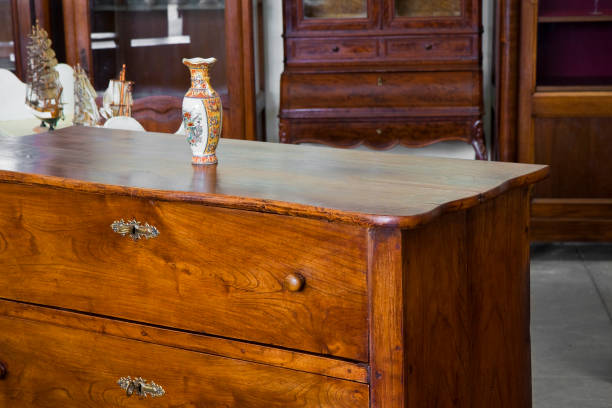
Start by removing all dust. Use a soft cloth or feather duster on your wooden furniture. For carvings and tight spots, try a soft paintbrush or vacuum with a brush attachment.
Dust your quality wood furniture weekly. This prevents scratches and stops dirt from embedding in the wood.
Always dust before using any wood cleaner or polish. Otherwise, you’ll just push dirt around and potentially scratch the surface.
2. Basic Cleaning for Light Dirt
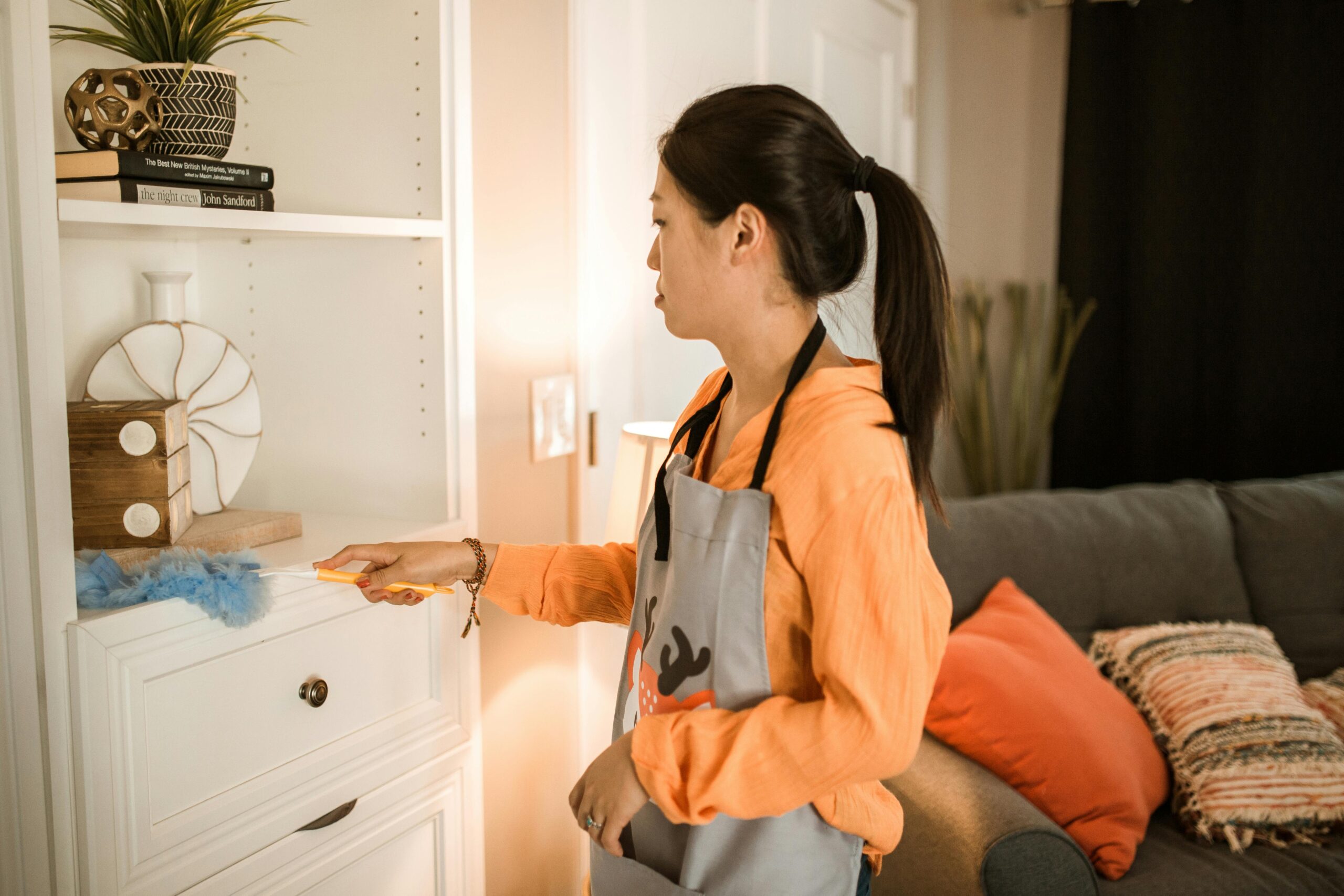
For lightly soiled solid wood furniture, use this simple approach:
- Mix a few drops of mild dish soap with warm water
- Dampen a soft cloth with the solution (not soaking wet)
- Wring the cloth until it’s barely damp
- Wipe with the wood grain
- Immediately dry with a clean cloth
Never let water sit on wood surfaces – it causes warping, staining, and finish damage. Keep old wood furniture as dry as possible during cleaning.
When using wood cleaner spray, apply it to your cloth first, not directly on furniture. This prevents oversaturation and gives better control.
3. Deep Cleaning for Stubborn Grime
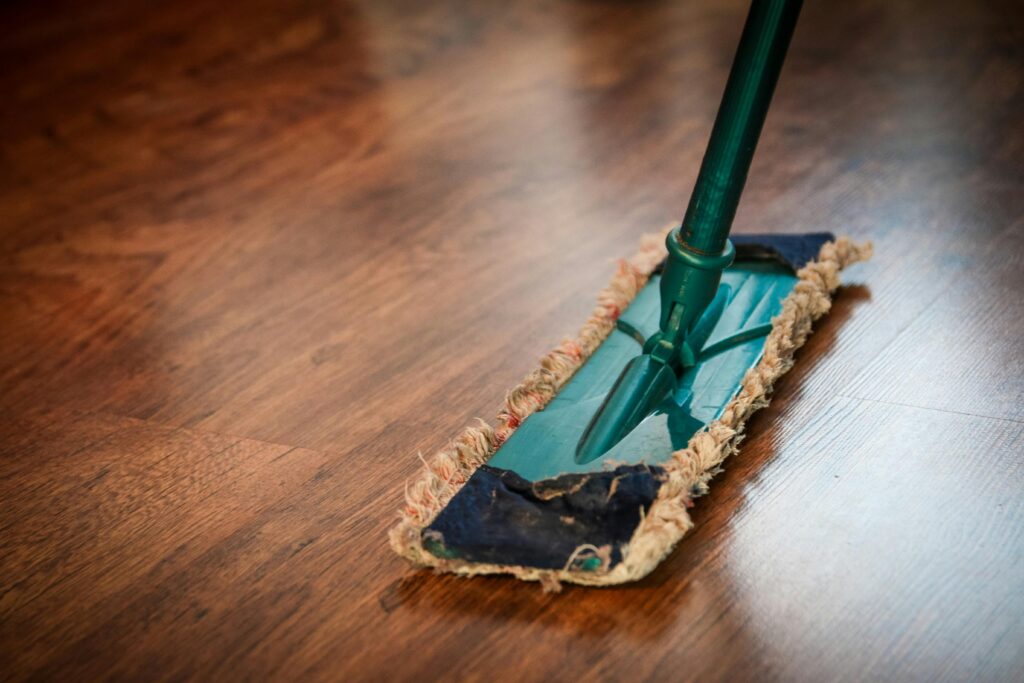
Heavily soiled old wood furniture may need stronger solutions:
For built-up grime on finished wood:
- Mix equal parts white vinegar and warm water
- Dampen a cloth with the solution and wring it well
- Clean a small area at a time, following the grain
- Dry immediately with a clean cloth
For greasy buildup, try a mild wood degreaser. These products cut through decades of kitchen grease and oils without harming most finishes.
Always follow degreasing with conditioning, since these products can strip natural oils from the wood.
4. Addressing Water Marks and Stains
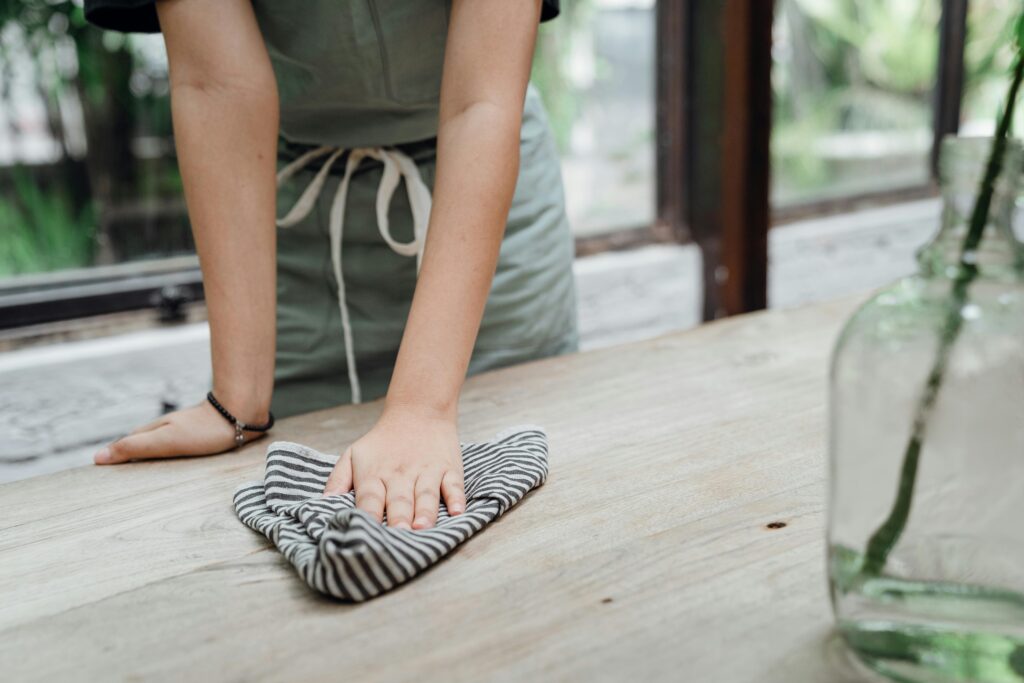
Fix water rings and heat marks on wood furniture without refinishing:
- For white water marks, gently rub with a mixture of equal parts white toothpaste (not gel) and baking soda
- For deeper stains on hardwood furniture, try a mixture of olive oil and salt
- Mayonnaise can sometimes remove water rings when left on overnight
For dark water stains that penetrate the finish, you might need professional wood restoration beyond basic cleaning.
5. Polishing and Protecting
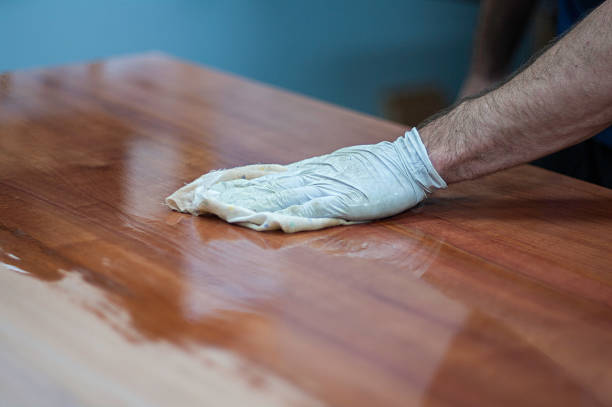
After cleaning, protect your old wood furniture with appropriate polish:
For most finished woods:
- Apply a small amount of best wood furniture polish to a soft cloth
- Rub into the wood following the grain
- Buff with a clean cloth until no residue remains
For oil-finished wooden furniture:
- Apply a thin coat of furniture oil (lemon or orange oil works well)
- Let it soak in for the recommended time
- Wipe away excess to prevent stickiness
Avoid silicone-based polishes on antique wood furniture. They build up over time and create a barrier that’s hard to remove later.
Preventative Care and Maintenance
Preventative Care and Maintenance
Regular care prevents the need for deep cleaning your wooden furniture:
- Dust weekly with a soft cloth
- Clean spills immediately before they stain
- Use coasters and placemats under drinks and dishes
- Keep real wood furniture away from direct sun and heat sources
- Maintain indoor humidity between 40-60% to prevent wood drying
Apply quality wood furniture polish every 1-3 months. This enhances appearance and protects wood surfaces.
For old wood furniture, consistent care works better than occasional deep cleaning. A little regular attention preserves your pieces.
Year-Round Care
Regular care keeps wood furniture mold-free. A consistent approach to maintenance prevents most mold problems before they start.
Year-round care includes:
- Wipe up spills right away
- Keep good air flow in rooms
- Dust wooden surfaces often
- Check hidden areas monthly
- Apply wood polish regularly
These simple habits protect your investment in quality wood furniture and maintain a healthy home environment. Prevention truly is easier than treatment.
Pro Tip
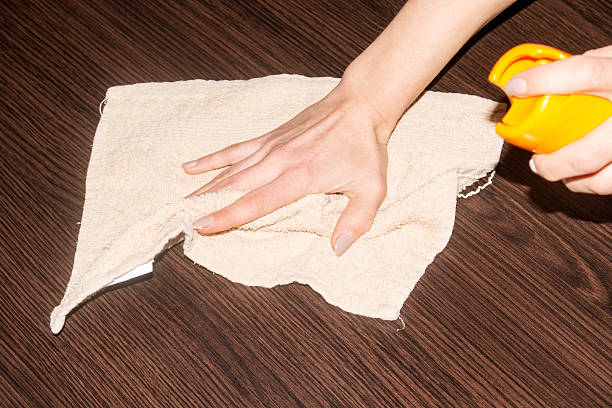
When cleaning antique wood furniture, always test cleaners in a hidden spot first. Older finishes can react unexpectedly to modern products, potentially causing irreversible damage.
Common Questions About Cleaning Old Furniture
How to get dirt out of wood?
For ingrained dirt in wooden furniture, mix equal parts vinegar and olive oil. Apply to the wood with a soft cloth and wipe with the grain. For detailed carvings, use a soft toothbrush to loosen dirt from crevices. Always follow with a clean, dry cloth.
How to clean wood with vinegar and baking soda?
Make a paste with equal parts baking soda and water. Apply to stained areas on your old wood furniture, then wipe with a vinegar-dampened cloth. The fizzing action lifts stains. This works best on raw or oil-finished wood, not on lacquered or polyurethane finishes.
What does baking soda do to wood?
Baking soda works as a mild abrasive that can remove stains from wood surfaces. Use it carefully – it can scratch delicate finishes and lighten wood if left too long. Always dilute baking soda with water and test in a hidden area first, especially on old antique furniture.
How to make homemade wood cleaner?
Create a simple wood cleaner by mixing 1 cup water, 1/4 cup white vinegar, 2 tablespoons olive oil, and a few drops of lemon essential oil. Mix in a spray bottle, apply to a cloth (never directly to wood), and wipe with the grain. This works well for routine cleaning of most wood furniture.
Can you use Pine-Sol on wood?
While manufacturers market Pine-Sol as safe for wood, it’s too harsh for fine wooden furniture, especially antique wood furniture. The strong detergents damage finishes and strip essential oils from wood. Stick to cleaners made specifically for wood surfaces or gentle soap solutions.
Is bleach or vinegar better for mold on wood?
Vinegar works better than bleach for cleaning mold off wood furniture. Bleach can’t soak into wood to reach deep mold. Vinegar kills mold at its source. Also, bleach can damage wood finishes and change wood color. It’s a common misconception that bleach is best for mold removal.
Taking Action: Wood Furniture Restoration
Know when to clean and when to restore your old wood furniture. Simple cleaning maintains appearance, but significant damage needs more intervention.
Call professionals when:
- The finish has serious damage or is missing
- Your piece needs structural repairs
- The item has high monetary or sentimental value
- You own museum-quality antique wood furniture
For everyday care of quality wood furniture, the gentle cleaning methods in this guide will preserve both beauty and function. Regular attention prevents most serious problems.
With proper care, your solid wood furniture will remain beautiful for years to come. These timeless pieces connect us to the past while serving our present needs—making them worth the effort of proper maintenance.
Remember that caring for old wood furniture is about preservation, not just cleaning. Each piece tells a story that proper care helps continue for generations.


